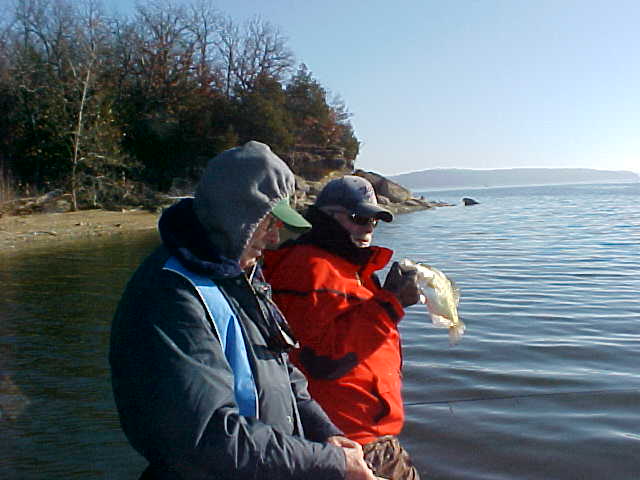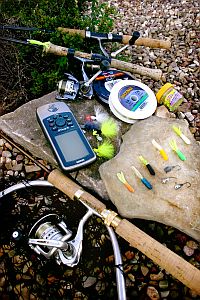Pre-Spawn Crappie
PRE-SPAWN CRAPPIES
I guess the first question most folks would ask is “what is the definition of pre-spawn crappie”? It’s actually a legitimate question and deserves some of my space to define. I prefer to think of the pre-spawn anytime from mid-January to mid-April or whenever the spawn actually begins. This period of time has many changes that occur that affects the bite and location of the fish. The water temperature is all important as well as the clarity of the water and length of day. January and February are two months closely related to one another for fish location and bite. Generally March and early April are completely different and requires a totally different strategy to catch fish. One has to erase the thought of only being able to catch crappie during the spring of the year on or along spawning banks and focus on locating and monitoring the fish during this period of time in deeper water. Great fishing and catching occurs during the pre-spawn if the angler is willing to withstand the elements and spend time on the water. Pre-spawn crappie feed aggressively and can be found in various depths, some depths which the average crappie fisherman would never explore.

JANUARY/FEBRUARY CRAPPIES
January and February are great months for catching pre-spawn crappies. The primary factor for locating the fish is the water depth. Since the surface water temperature has reached about the same temperature or possibly colder than the deeper water, there is a turning over effect which allows the cooler, oxygen rich water to replace the deeper water. The warmer deeper water will rise to the surface. This turning over of the water elongates the oxygen column and allows the bait fish and crappies to go deeper in the reservoir. As a result, deeper structure will hold the bait fish and attract the crappie. Also, the shad (primary bait fish) will form large schools and swim along major tributary drops and channels in the deeper water. The key to finding the crappie is to locate these schools of shad. If the shad can be located and stay together in a common location for a period of time, you can fish down in the mass of the school and catch good numbers of fish. Every day is a new day as far as the shad location and their schooling density. I have fished areas and found shad for two or three days in a row and show up the fourth day and the school of shad would not stay together or were completely gone altogether. The end result for this situation is to relocate and find some new schools of shad. Keep in mind, “the colder the water, the deeper the fish”.
I look for shad in the mouths of deep coves, off of deep drop-off banks, creek and river channel drops, off of long shoaling points, and out from traditional crappie beds only in deeper water. The depth of these bait fish may vary from water depths in the 20’s to up to 70 foot mark or deeper. The use of electronics for locating these fish is all important. Side imaging, down imaging, and 360 degree imaging are all extremely useful for locating schools of shad. I prefer the Hummingbird models of graphs due to the user friendliness of the units. There are other makes and models so whichever unit works for you is the one to use. Surprisingly, the location of the schools of shad are similarly located in close proximity of where you’ve found them from year to year. Once shad “wads” have been found, the control of the boat to stay on top of them or keep up with their movement is imperative. Boat control will make a difference of whether you catch fish or get hung up in deep structure. Practicing boat control in all kinds of wind conditions will pay dividends throughout the year. Most generally if there is cover and bait fish, there will be crappie close by. When the bite slows or quits completely, move to a new location.
Studying lake maps and knowing the structure of the lake is beneficial for having multiple areas to search out schools of shad. Knowing and locating deep structure gives you more places to fish and catch the deep crappie. When fishing the deeper fish, I will turn to 1/8th to ¼ oz. jig heads. I will also use larger bodied jig bodies up to 3-4 inches long. Some folks might think that size of bait is too big but I have pulled crappie up out of deep water that had 4-6 inch shad in their mouths with tails hanging out of their mouths. Thus, crappie will eat big baits. The advantage of the heavier weighted jigs is that it will fall faster and not take so long to get in the fish zone. It takes a 1/16th oz. jig a long time to fall 40-70 feet. The longer it takes to get the bait in the zone the more time is wasted and it allows the shad school to move away from you. I prefer any color of jig body that has chartreuse in it. Glow colors are also my preference.
Combinations of Black/Chart, Red/Chart, Brown/Chart, Green/Chart, and White/Chart are all good as well as all glow Chartreuse. Mike’s Custom jigs are well worth the money as well as the Mid South Super Tube Jigs.
I use monofilament 4 lb. test line or lighter spooled on a Lew’s or Shimano ultralight spinning reel. The rod of my choice is the Lew’s 7 foot Wally Marshall Signature Series ultralight with a fast action tip or a GLoomis SR781 6 ½ foot ultralight with a fast action tip. I like the longer rods for all my crappie fishing because the hook set is more defined and when the fish is hooked I can raise the fish 3-4 feet immediately. The fast action ultralight tip allows me to detect the bite more easily. You have to pay close attention to the rod tip and line because many of the bites will NOT be felt but rather seen. The tip may just barely move or the line may just twitch when the bite occurs. My rule of thumb on the bite is “if in doubt, jerk”.
MARCH/EARLY APRIL
As the days get longer and the water begins to warm up, the crappie will make their migration to the spawning banks. During this time period, catching fish can become difficult to say the least. The crappie begin to stage up in the mouths of coves or become suspended along migration routes to the spawning banks. The method of catching these fish will change drastically. Some days they will congregate around structure and the traditional method of vertical jigging or pitching and drifting will catch fish. More days than not, the fish will be roaming around following small groups of bait fish suspended in no particular pattern. The only definite characteristic of the fish during this time is that they will be located somewhere close to spawning banks.
Casting and retrieving roadrunners or slow trolling (spider rigging) them or jigs seems to work well when the fish are in this transition. Patience is a must when fishing these conditions. The retrieve or method of bait retrieve must be slow, slow, slow. Some folks prefer to drift live minnows through the masses of suspended fish. The use of electronics for locating the fish is imperative. I have found that a good majority of these fish will “stack” up in the middle of coves. If you find fish in this pattern, turn your boat perpendicular to the bank and drift sideways through the fish either dragging a minnow or jig, or cast and retrieve a roadrunner or jig through the mass using a slow retrieve. Patience and perseverance are necessary and will prove to be productive. When the fish are shallower during this transition, I will tend to use lighter colored jig bodies such as blues and pinks. Shad colored baits also will produce fish.
%20graph.JPG)
Another method of catching these pre-spawn fish is to pull crank baits. You must determine the depth of the suspended fish and use baits that will dive only to that depth or slightly shallower. You must remember that the fish will come up underneath the bait to bite so you don’t want to use baits that dive below the fish.
Keep a close eye on the water temperature. When the water warms to the 56-58 degree mark, the fish will start to move toward the banks marking the beginning of the spawning pattern. The spawn will be in full swing once the surface temperature of the water reaches 60 degrees and the daylight hours reach the 12 hour plus mark. If you are looking for a date to “hang your hat on” for the beginning of the spawn, I say somewhere two weeks before or after April 21st.
In the meantime, “keep your line tight and sit and Jerk”!
Rick Flint

